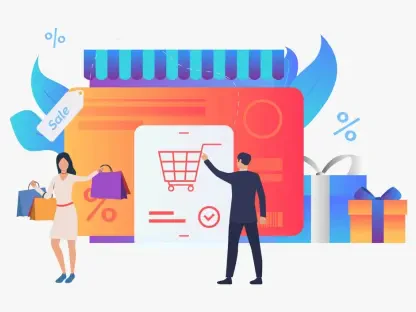As the financial world rapidly evolves, few sectors have manifested transformation as evidently as the payments industry has over the last few years. In 2025, the confluence of technological advancement and changing consumer expectations has propelled payments into a new era. Businesses across the globe—from giant retail chains to niche online marketplaces—are deeply affected by the need to stay ahead of payment innovations. The landscape is dominated by emerging technologies and a variety of payment methods promising strides in transaction efficiency, security measures, and user satisfaction. This article delves into six transformative trends that have come to define the payments ecosystem as it stands today.
Transition to Digital and Alternative Payment Methods
Digital Wallets and BNPL Flexibility
Over recent years, the significance of digital wallets has increased exponentially, challenging the dominance of traditional methods like cash and credit cards. With the projection of digital wallet transactions soaring to approximately $25 trillion by 2027, their adoption reflects consumers’ desire for seamless transaction experiences. Buy Now, Pay Later (BNPL) schemes, translating consumer affinity into real-world growth, are platforms gaining traction due to their user-friendly framework. Popularized by companies such as Klarna, Afterpay, PayPal, and Affirm, these options offer consumers unparalleled flexibility in payment methods. Merchants recognizing this shift have noted the importance of integrating alternative payment methods in their checkout processes, particularly as specific markets increasingly favor such innovative solutions.
Implications for Merchants and Consumers
For merchants, the adoption of alternative payment methods is no longer just an option—it’s a necessity. In markets where digital natives dominate the consumer base, failing to offer digital wallets or BNPL options could result in lost sales opportunities. Meanwhile, consumers benefit from the heightened convenience and ease of access these methods provide, often leading to enhanced purchasing power. As these payment options become mainstream, a profound restructuring of payment services is happening. This transformation has the potential to redefine business models, encouraging investment in technology that supports seamless integration and interoperability across platforms.
Advancing Security with Biometrics and Tokenization
Protecting Transactions with Biometric Authentication
With the ever-growing threat of payment fraud, businesses are tasked with adopting robust security measures to protect consumer transactions. Biometric authentication stands out as a popular mechanism, leveraging the uniqueness of individual characteristics. Technologies like facial recognition, fingerprint identification, and retinal scans have progressively entered the payment sphere, offering higher security levels than previous standard methods. Consumers, increasingly concerned about privacy and personal data breaches, find greater assurance in these advanced verification protocols. With technological advancements in this arena, deploying and managing biometric systems have become more feasible, aligning with rigorous regulatory requirements and elevating consumer trust.
The Rise of Tokenization
Tokenization has emerged as a crucial element in securing transactions, gaining traction among 78% of merchants who employ either network or payment tokens. By substituting sensitive financial data with non-sensitive equivalents, businesses can significantly mitigate the risk of data breaches. This protective layer not only shields valuable information but also streamlines transaction processing by reducing friction and delays caused by fraud vulnerabilities. As regulatory oversight evolves and technological innovations continue, the deployment of tokenization measures is expected to expand. Retailers and financial institutions recognize the necessity of adopting more secure methods to maintain competitive standing in a progressively digitized world.
Consumerization of B2B Payments
Transformation in B2B Transactions
The revolution in payment systems is not confined to consumer markets. Business-to-business transactions have undergone significant transformations, driven by a demand for efficiency and cost-effectiveness. Outdated methods such as paper checks and traditional transfer approaches are rapidly being replaced by sophisticated B2B payment frameworks. These systems streamline transactions, automate processes, and enhance relationships between enterprises. The shift towards more efficient, transparent global payouts and improved internal processes signifies businesses’ commitment to leveraging technology for streamlining operations. These innovations not only benefit the immediate transaction landscape but also contribute to improving processes like reconciliation, reporting, and routing, which underpin overall operational efficiency and effectiveness.
Scaling Global Business Operations
As businesses increasingly engage across borders, a sophisticated approach to B2B payments becomes indispensable for scaling operations efficiently. Adapting to various international standards, payment platforms, and currency exchanges, enhanced B2B frameworks offer flexibility crucial for global expansion. By ensuring seamless integration with existing systems, these platforms simplify the complexities associated with global commerce. The rising demand for real-time financial data, visibility across supply chains, and integrated solutions demonstrates how modern payment innovations can profoundly impact business operations. These evolved processes foster improved collaboration and trust among international partners, supporting sustainable growth across diverse markets.
Strategic Role of Payment Orchestration
Orchestrating Payment Frameworks for Growth
Payment orchestration has increasingly become a vital component for businesses seeking competitive edges through revenue growth and consumer satisfaction. Initially perceived as a technical integration process balancing multiple payment providers, it is now recognized for its strategic value. Companies employing payment orchestration report enhanced customer experiences and improved acquisition rates, underscoring the influence on bottom-line metrics. The tools provided through orchestration, including seamlessly incorporating diverse payment options and optimizing transactions globally, help businesses navigate the complexities of the payment landscape. Additionally, these systems provide critical mechanisms to combat challenges such as false declines and fraud, paving the way for the adoption of the latest payment innovations.
Expanding Payment Capabilities
For businesses aiming to adapt swiftly to evolving payment dynamics, an orchestrated payment approach is instrumental. The adaptation involves incorporating functionalities that enhance international transactions, provide agility across various economic zones, and embrace modern payment technologies. These updated capabilities empower organizations to better serve their widespread consumer bases while ensuring successful transaction executions across borders. The strategic implementation of payment orchestration resolves underlying technical challenges and reimagines payment processes as a cornerstone for achieving competitive differentiation, enhancing consumer trust and overall satisfaction. This paradigm shift invites companies to rethink their payment architecture in alignment with broader strategic goals.
Necessity of Localization for Global Reach
Navigating Regional Payment Preferences
The payments landscape has become increasingly fragmented, reflecting regional variances in consumer preferences and payment types. For companies branching into the global market, understanding and adapting to these differences is paramount. Localization involves customizing payment methods based on consumers’ preferences across geographic boundaries. For example, U.S. consumers might favor certain digital wallets and real-time payment apps that may differ significantly from those in the Asia-Pacific or Latin American regions. Companies must navigate complex geo-specific regulations, support diverse privacy laws, and accommodate varied currency exchanges to efficiently and successfully penetrate these markets, adopting a global strategy with a local perspective.
Regulations and Market Integration
Localizing payment methods at scale is crucial for companies aiming to capture broad consumer bases and enhance their market penetration. This strategic emphasis on regional adaptation requires alignment with local regulations, currency fluctuations, and consumer expectations to ensure seamless integration into new markets. Companies leveraging payment localization effectively can maximize opportunities in untapped areas, turning regional complexities into competitive advantages. As organizations strive for excellence in international markets, localization becomes the linchpin for aligning consumer satisfaction with market growth, facilitating successful navigation of the intricate web of payment preferences across diverse cultural and regulatory landscapes.
User Experience’s Impact on Revenue
Addressing Cart Abandonment Challenges
The checkout experience plays a pivotal role in shaping consumer satisfaction and influencing potential revenue streams for businesses. Complex or cumbersome checkout procedures are the primary factors deterring consumers, leading to significant cart abandonment rates. Merchants need to address this by streamlining their processes, ensuring simplicity and efficiency. Research indicates that nearly 21% of shoppers abandon their carts due to a complicated checkout experience, translating into substantial revenue losses. Beyond simplifying the procedure, offering consumers their preferred payment methods is crucial. Approximately 61% of shoppers highlight the absence of preferred payment options as a key reason for abandoning purchases, indicating the need for a comprehensive payment strategy.
Recovery and Revenue Optimization
As the financial world undergoes rapid changes, few sectors have experienced such visible transformation as the payments industry in recent years. In 2025, technological progress and evolving consumer expectations have ushered payments into a new era. Businesses worldwide—from major retail giants to specialized online marketplaces—must adapt to stay ahead in a landscape shaped by payment innovations. New technologies and an array of payment methods have emerged, promising improvements in transaction speed, security, and user satisfaction. Companies are now tasked with integrating these advancements to maintain a competitive edge while ensuring they meet the growing demands of consumers who prioritize convenience and security. This article explores six key transformative trends that define the current payments ecosystem. These trends not only refine the way businesses operate but also reshape consumer interactions, streamlining processes that were once cumbersome. As these trends unfold, they bolster both efficiency and trust, marking a pivotal moment in the payment industry’s evolution.








